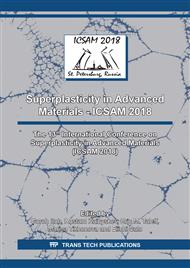[1]
M. Kawasaki, R.B. Figueiredo, T.G. Langdon, The Requirements for Superplasticity with an Emphasis on Magnesium Alloys, Advanced Engineering Materials 18(1) (2016) 127-131.
DOI: 10.1002/adem.201500068
Google Scholar
[2]
K. Matsubara, Y. Miyahara, Z. Horita, T.G. Langdon, Developing superplasticity in a magnesium alloy through a combination of extrusion and ECAP, Acta Materialia 51(11) (2003) 3073-3084.
DOI: 10.1016/s1359-6454(03)00118-6
Google Scholar
[3]
M. Kai, Z. Horita, T.G. Langdon, Developing grain refinement and superplasticity in a magnesium alloy processed by high-pressure torsion, Materials Science and Engineering A 488(1-2) (2008) 117-124.
DOI: 10.1016/j.msea.2007.12.046
Google Scholar
[4]
R.B. Figueiredo, M. Kawasaki, T.G. Langdon, Developing superplasticity in metallic alloys through the application of severe plastic deformation, Materials Science Forum, 2009, pp.97-111.
DOI: 10.4028/www.scientific.net/msf.604-605.97
Google Scholar
[5]
R.B. Figueiredo, T.G. Langdon, Developing superplasticity in a magnesium AZ31 alloy by ECAP, Journal of Materials Science 43(23-24) (2008) 7366-7371.
DOI: 10.1007/s10853-008-2846-0
Google Scholar
[6]
R.B. Figueiredo, T.G. Langdon, Record Superplastic Ductility in a Magnesium Alloy Processed by Equal-Channel Angular Pressing, Advanced Engineering Materials 10 (2008) 37-40.
DOI: 10.1002/adem.200700315
Google Scholar
[7]
R.B. Figueiredo, T.G. Langdon, The development of superplastic ductilities and microstructural homogeneity in a magnesium ZK60 alloy processed by ECAP, Materials Science and Engineering A 430(1-2) (2006) 151-156.
DOI: 10.1016/j.msea.2006.05.056
Google Scholar
[8]
R.Z. Valiev, T.G. Langdon, Principles of equal-channel angular pressing as a processing toold for grain refinement, Progress in Materials Science 51 (2006) 881-981.
DOI: 10.1016/j.pmatsci.2006.02.003
Google Scholar
[9]
A.P. Zhilyaev, T.G. Langdon, Using high-pressure torsion for metal processing: Fundamentals and applications Progress in Materials Science 53(6) (2008) 893-979.
DOI: 10.1016/j.pmatsci.2008.03.002
Google Scholar
[10]
R.B. Figueiredo, T.G. Langdon, Strategies for achieving high strain rate superplasticity in magnesium alloys processed by equal-channel angular pressing, Scripta Materialia 61(1) (2009) 84-87.
DOI: 10.1016/j.scriptamat.2009.03.012
Google Scholar
[11]
R.B. Figueiredo, S. Sabbaghianrad, A. Giwa, J.R. Greer, T.G. Langdon, Evidence for exceptional low temperature ductility in polycrystalline magnesium processed by severe plastic deformation, Acta Materialia 122 (2017) 322-331.
DOI: 10.1016/j.actamat.2016.09.054
Google Scholar
[12]
R.B. Figueiredo, F.S.J. Poggiali, C.L.P. Silva, P.R. Cetlin, T.G. Langdon, The influence of grain size and strain rate on the mechanical behavior of pure magnesium, Journal of Materials Science 51(6) (2016) 3013-3024.
DOI: 10.1007/s10853-015-9612-x
Google Scholar
[13]
H. Somekawa, T. Mukai, Hall–Petch Breakdown in Fine-Grained Pure Magnesium at Low Strain Rates, Metallurgical and Materials Transactions A 46(2) (2015) 894-902.
DOI: 10.1007/s11661-014-2641-2
Google Scholar
[14]
J. Straska, M. Janecek, J. Gubicza, T. Krajnak, E.Y. Yoon, H.S. Kim, Evolution of microstructure and hardness in AZ31 alloy processed by high pressure torsion, Materials Science and Engineering A 625 (2015) 98-106.
DOI: 10.1016/j.msea.2014.12.005
Google Scholar
[15]
J. Xu, X.W. Wang, M. Shirooyeh, G.N. Xing, D.B. Shan, B. Guo, T.G. Langdon, Microhardness, microstructure and tensile behavior of an AZ31 magnesium alloy processed by high-pressure torsion, Journal of Materials Science 50(22) (2015) 7424-7436.
DOI: 10.1007/s10853-015-9300-x
Google Scholar
[16]
L.R.C. Malheiros, R.B. Figueiredo, T.G. Langdon, Grain size and microhardness evolution during annealing of a magnesium alloy processed by high-pressure torsion, Journal of Materials Research and Technology 4(1) (2015) 14-17.
DOI: 10.1016/j.jmrt.2014.10.008
Google Scholar
[17]
R.B. Figueiredo, T.G. Langdon, Grain refinement and mechanical behavior of a magnesium alloy processed by ECAP, Journal of Materials Science 45(17) (2010) 4827-4836.
DOI: 10.1007/s10853-010-4589-y
Google Scholar
[18]
K.S. Fong, A. Danno, M.J. Tan, B.W. Chua, Tensile flow behavior of AZ31 magnesium alloy processed by severe plastic deformation and post-annealing at moderately high temperatures, Journal of Materials Processing Technology 246(Supplement C) (2017).
DOI: 10.1016/j.jmatprotec.2017.03.025
Google Scholar
[19]
H.K. Lin, J.C. Huang, T.G. Langdon, Relationship between texture and low temperature superplasticity in an extruded AZ31 Mg alloy processed by ECAP, Materials Science and Engineering: A 402(1) (2005) 250-257.
DOI: 10.1016/j.msea.2005.04.018
Google Scholar
[20]
Y.Q. Cheng, H. Zhang, Z.H. Chen, K.F. Xian, Flow stress equation of AZ31 magnesium alloy sheet during warm tensile deformation, Journal of Materials Processing Technology 208(1) (2008) 29-34.
DOI: 10.1016/j.jmatprotec.2007.12.095
Google Scholar


